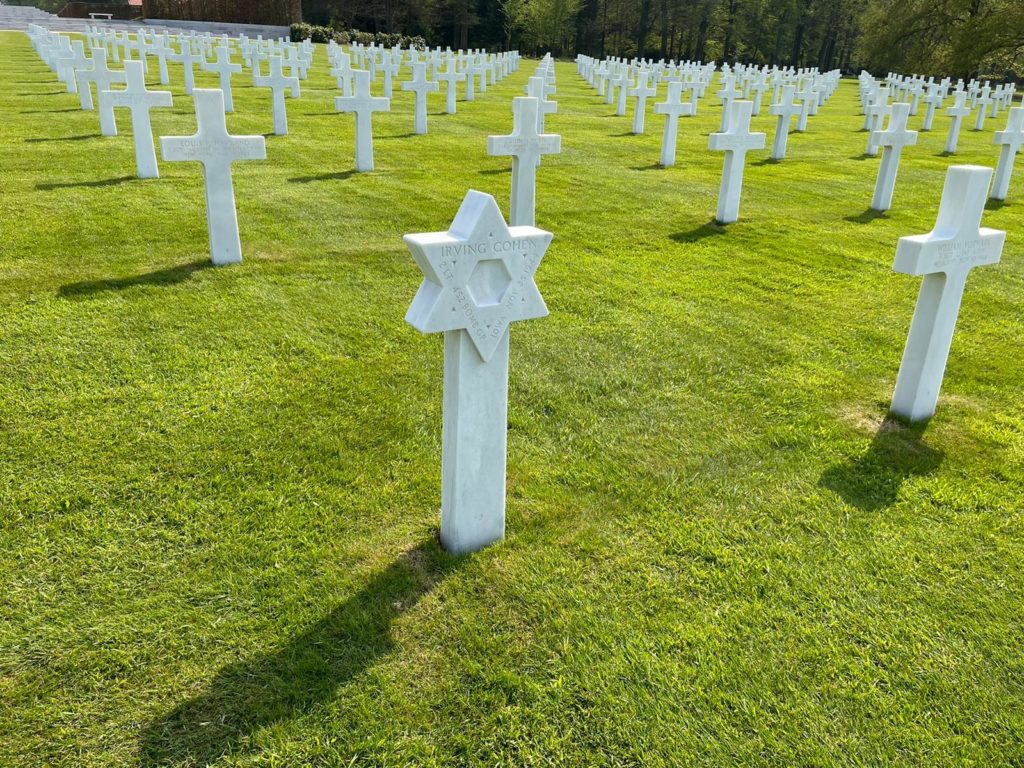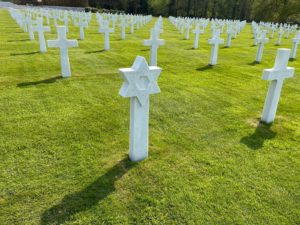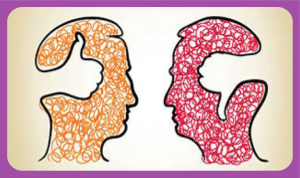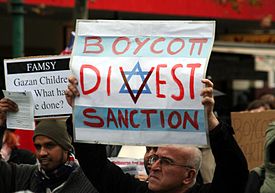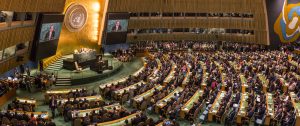Published in Jewish News Syndicate (JNS)
May 8, 2022
How Operation Benjamin connects people with their forgotten past and Jewish identity
Benjamin Garadetsky fought with courage and died on August 23,1944 in service of the 2nd Armored Division in Europe. Benjamin was just one example of the over 550,000 Jews who fought to defeat Nazism during World War II. From his birthplace in Zhitomir, Russia to the shores of Ellis Island, to the streets of the Bronx, to the battlefields of Europe, Benjamin Garadetsky lived as Jew. He died a Jewish-American hero and was laid to rest at Normandy American Cemetery and Memorial in Colleville-sur-Mer, France, along with 9,386 other heroes of the war.
And here our story begins.
For various unintended reasons—along with an estimated 500 other soldiers—Benjamin was buried under a Latin Cross and not the Star of David. One of the two main reasons for these errors was related to paperwork during the multiple reburials of these soldiers. But the more ironic reason was Jewish soldiers’ reluctance to wear dog tags with the identifying “H” for Hebrew, as they feared certain death in the hands of the Nazis, thus they enlisted as Christians. These historical errors are being painstakingly researched and corrected by a small team that has taken it upon themselves to welcome these war heroes into the bosom of the Jewish people once more.
Rabbi J.J. Schacter, Professor of Jewish History at Yeshiva University, discovered these historical errors back in 2014 while visiting Normandy. Months later, he mentioned the missing Stars of David to a friend and military historian, Shalom Lamm. Together, they decided to take action, and their first experiment with the process was in connection to the headstone of Benjamin Garadetsky. From this experience, Operation Benjamin (www.operationbenjamin.org) was born.
Changing a soldier’s burial marker is a very difficult process, as it should be. The American Battle Monuments Commission (ABMC) administers the Normandy American Cemetery along with 25 other cemeteries located in 17 foreign countries. These beautifully arranged and maintained cemeteries are a symbol of America’s role in defeating Nazism. They are very special and, I dare say, holy places. The ABMC is tasked with the maintenance of the integrity and beauty of these cemeteries. As such, they dictate the process by which a gravestone is changed.
Subscribe to The JNS Daily Syndicate by email and never miss our top stories
Your email
Above all, one must prove beyond any doubt that the soldier in question was Jewish at the time of his death. Most of these soldiers were young and unmarried. In some cases, it is difficult to find direct proof that the soldier lived and died as a Jew. The ABMC, which is supportive of Operation Benjamin, requires this level of absolute proof to make the switch. But there is also a second major challenge. That is to find a relative to make the request for such a change because only a family member can initiate the process. Operation Benjamin, it turns out, was not just about changing stones but changing lives. It reconnected people with their forgotten past and, in some cases, their dormant Jewish identity.
Operation Benjamin realized that to overcome these two fundamental challenges, they needed a top-notch genealogist, which they found in Rachel Silverman. With her expert assistance, they have been making slow though quite substantial progress. In each case, a full genealogical analysis of each war hero who is identified as Jewish under a Latin Cross is compiled for both the family and the ABMC.
I was privileged to participate in gravestone-changing ceremonies for seven soldiers interred in four cemeteries: Epinal and Lorraine in France, along with Luxembourg and the Ardennes Military in Belgium. Each ceremony is crafted with care to show the appropriate respect for both the institution and the individual. Each soldier and their family—most of whom attended—had their special story, such as a daughter reunited with her dad after his death in battle when she was two years old. All their stories are our stories of heroism and loss.
These ceremonies have cemented a special bond between the U.S. Military as represented by ABMC and Operation Benjamin as a representative of the broader Jewish community. Each cemetery has a superintendent responsible for maintaining strict and consistent AMBC standards. They have strongly supported the efforts of Operation Benjamin since nothing is as important as having an accurate historical record. This collaboration is very special.
Shalom Lamm said to me at one point, “We live in an age of rapidly increasing anti-Semitism. It’s very important for us to recognize that Jewish blood was spilled in equal measure to their peers to protect the world’s freedom and democracy from the forces of tyranny and evil.”
At each closing ceremony, Rabbi Schacter approaches the grave of our fallen hero, his head deeply bowed in respect and awe. After a long pause—and here I use one of the soldiers’ names—he states: “Private Marvin Ashkenas, on behalf of the citizens of the United States of America, we thank you for your service. And, Marvin, on behalf of the Jewish people, we welcome you home.” And for every soldier we embraced in those two days, we stood in silence and wept.
Samuel Solomon was a participant in an Operation Benjamin mission on April 26 and 27, 2022. He founded a pro-Israel network and is involved in Israel’s tech sector. More information on him may be found at sam-solomon.com. Operation Benjamin information and resources may be found at www.operationbenjamin.org.


